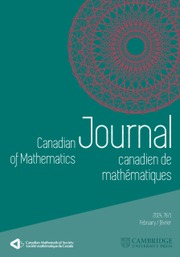No CrossRef data available.
Article contents
Two general series identities involving modified Bessel functions and a class of arithmetical functions
Published online by Cambridge University Press: 10 October 2022
Abstract
We consider two sequences  $a(n)$ and
$a(n)$ and  $b(n)$,
$b(n)$,  $1\leq n<\infty $, generated by Dirichlet series
$1\leq n<\infty $, generated by Dirichlet series  $$ \begin{align*}\sum_{n=1}^{\infty}\frac{a(n)}{\lambda_n^{s}}\qquad\text{and}\qquad \sum_{n=1}^{\infty}\frac{b(n)}{\mu_n^{s}},\end{align*} $$
$$ \begin{align*}\sum_{n=1}^{\infty}\frac{a(n)}{\lambda_n^{s}}\qquad\text{and}\qquad \sum_{n=1}^{\infty}\frac{b(n)}{\mu_n^{s}},\end{align*} $$
satisfying a familiar functional equation involving the gamma function  $\Gamma (s)$. Two general identities are established. The first involves the modified Bessel function
$\Gamma (s)$. Two general identities are established. The first involves the modified Bessel function  $K_{\mu }(z)$, and can be thought of as a ‘modular’ or ‘theta’ relation wherein modified Bessel functions, instead of exponential functions, appear. Appearing in the second identity are
$K_{\mu }(z)$, and can be thought of as a ‘modular’ or ‘theta’ relation wherein modified Bessel functions, instead of exponential functions, appear. Appearing in the second identity are  $K_{\mu }(z)$, the Bessel functions of imaginary argument
$K_{\mu }(z)$, the Bessel functions of imaginary argument  $I_{\mu }(z)$, and ordinary hypergeometric functions
$I_{\mu }(z)$, and ordinary hypergeometric functions  ${_2F_1}(a,b;c;z)$. Although certain special cases appear in the literature, the general identities are new. The arithmetical functions appearing in the identities include Ramanujan’s arithmetical function
${_2F_1}(a,b;c;z)$. Although certain special cases appear in the literature, the general identities are new. The arithmetical functions appearing in the identities include Ramanujan’s arithmetical function  $\tau (n)$, the number of representations of n as a sum of k squares
$\tau (n)$, the number of representations of n as a sum of k squares  $r_k(n)$, and primitive Dirichlet characters
$r_k(n)$, and primitive Dirichlet characters  $\chi (n)$.
$\chi (n)$.
MSC classification
Information
- Type
- Article
- Information
- Copyright
- © The Author(s), 2022. Published by Cambridge University Press on behalf of The Canadian Mathematical Society
Footnotes
The first and second authors sincerely thank the MHRD SPARC project SPARC/2018-2019/P567/SL for their financial support. The first author is also supported by a grant from the Simons Foundation. The third author is a postdoctoral fellow at IIT Gandhinagar supported, in part, by the grant CRG/2020/002367.


